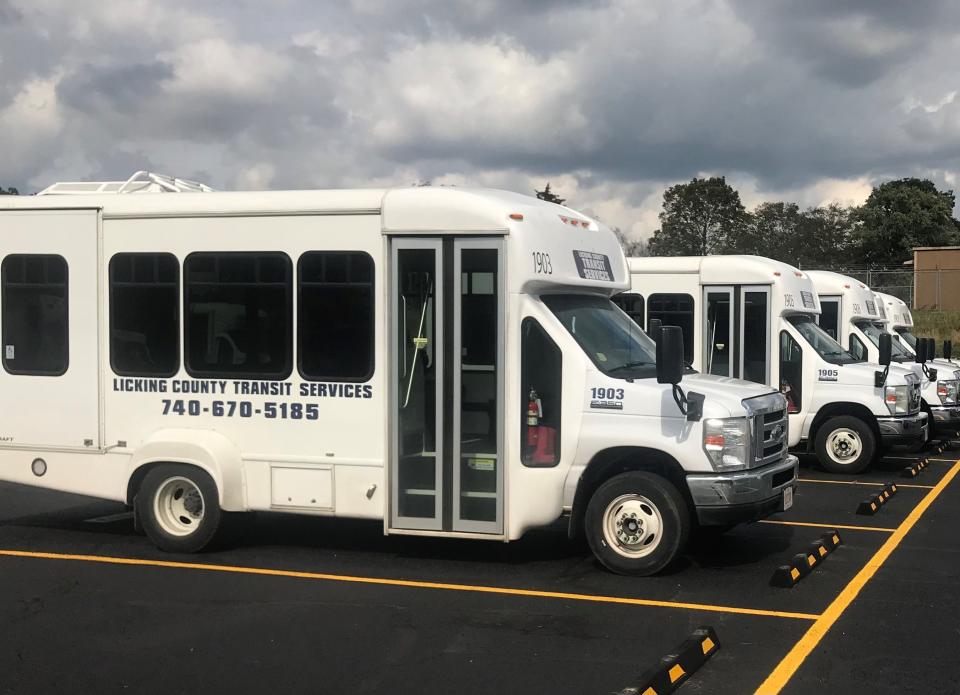COTA pays Licking County transit director's salary as it struggles with route cuts

Licking County Transit's executive director makes $178,357 a year, but that county does not pay a penny of it.
Instead, the Central Ohio Transit Authority does, since it loaned Matt Allison in 2022 to Licking County, which was searching for a new director.
Allison is a 34-year COTA employee who had been its chief of transit operations before COTA's one-year contract with Licking County began in May 2022.
More:Licking County Transit Board disbands as county transitions for Intel influx
Josh Lapp, who chairs the Transit Columbus advocacy group, said while COTA does need to integrate with surrounding transit systems as the region grows, he hopes that in the long-term someone other than COTA picks up that salary.
"I think COTA definitely has a lot of issues that need addressed," Lapp said.
"They obviously should be using resources to restore service," he said, referring to service cuts COTA made after the COVID-19 pandemic swept through almost three years ago which have not been fully restored, in part, because it can't hire enough drivers.

Allison leads Licking County Transit as it plans to to begin its first fixed-route service this summer, a pilot program with two legs:
● One that will connect Ohio State University's Newark campus with Denison University in Granville, Central Ohio Technical College and the The Career and Technology Education Centers of Licking County (C-TEC).
● The other leg connects Licking Memorial Hospital in Newark with related providers, including the Licking County Aging Program.
Currently, Licking County Transit is an "on-demand' service with no fixed routes. It had 61,630 trips in 2022.
Licking County's year-long contract with COTA for Allison's services does expire in May, although Patrick Harris, COTA's vice-president of external relations, said he sees no reason that it won't continue.
After that, Licking County may pick up part of the tab, Licking County Commissioner Rick Black said. But Harris said the intent is that Allison would remain a COTA employee.
"We're still in the negotiating phase of what a contract would look like," Harris said.
COTA also contributes to Allison's medical, vision, and dental plans, and contributes to his state retirement plan.
By comparison, the annual salary of COTA president and CEO Joanna Pinkerton is $350,097.
COTA collects a 0.5% sales tax in Franklin County, and parts of Delaware, Fairfield, Licking and Union counties.
Craig Treneff, who chairs the COTA board, said COTA can't fund Allison's position indefinitely. But he said that eventually public transportation around central Ohio is going to have to be looked at as a regional effort, and that COTA can learn from this experience with Licking County.
"I think we have to start thinking about what transit looks like for COTA in the future," he said.
COTA and Licking County officials have been talking about how the systems could work together as plans move forward on the transformative $20-billion Intel development in New Albany in western Licking County.
"It's too early to say how we'll be working together," Harris said. "Certainly our future plans are impacted by Intel."
Licking County Transit began in 1998 and now has an annual $4.5-million operating budget. COTA's 2023 operating budget is $189.5-million, by comparison.
Licking County Transit has 52 employees, including 35 drivers, up from 24 last year.
"We could not provide service because of a lack of drivers," Allison said. "We realized we were struggling because of that. There's been a critical focus on recruitment and retention."
Black said he hopes Licking County has a future relationship with COTA. He said county leaders reached out to COTA for a director after Licking County Transit's director retired for health reasons.
"With all the development that we’re facing there's more of a need for public transit," Black said. "Working with COTA, they have experts we can tap into."
Transit officials said the region's public transit system needs to grow if it is going to keep up with the increase in the number of jobs and residents in Greater Columbus.
Even before the Intel announcement, Licking County had already added at least 30,000 jobs since 2010, including 11,500 at distribution centers (such as Amazon) in Etna and Pataskala, 10,000 at New Albany's Beauty Park and technology centers, and 8,500 at the Heath Newark Licking Port Authority.
Intel is expected to hire 3,000 workers for its two New Albany fabs, plus 7,000 construction workers to build them for a projected 2025 opening.
Nick Gill, transportation director for the Mid-Ohio Regional Planning Commission, said COTA has been working with other counties to maker better transit connections. That's important, he said, as the regional planning commission updates its Metropolitan Transportation Plan that identifies problems in transportation systems here while laying out strategies for dealing with projected population increases. The population in the central Ohio region is expected to exceed 3 million people by 2050.
"People travel from county to county," Gill said.
"Some of those connections need to be stronger," he said. "We need to work through the way for those to occur."
mferench@dispatch.com
@MarkFerenchik
This article originally appeared on The Columbus Dispatch: COTA pays Licking County Transit director's salary despite local cuts
